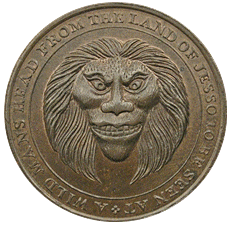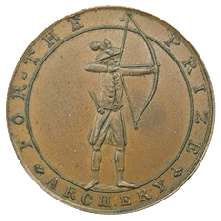
EARLY TOKEN HISTOR
Written by William McKivor
all images owned by www.thecoppercorner.com
EARLY TOKEN HISTORY - INTRINSIC VALUE
 Over the centuries, money came to be accepted in disk form that contained the actual — or close to the actual — value of the metal from which it was made. In England in the eighth century, the silver penny formed the basis of coinage. As silver and gold were not worth as much as they are today, a silver penny was the smallest coin — if one wanted a smaller denomination, the penny was cut into halves (half-pennies) or fourths (a fourth-thing, or "farthing"). As the price of silver rose due to finding other uses for it, the coins became smaller and smaller, making it very hard to make coin useful to the public.
Over the centuries, money came to be accepted in disk form that contained the actual — or close to the actual — value of the metal from which it was made. In England in the eighth century, the silver penny formed the basis of coinage. As silver and gold were not worth as much as they are today, a silver penny was the smallest coin — if one wanted a smaller denomination, the penny was cut into halves (half-pennies) or fourths (a fourth-thing, or "farthing"). As the price of silver rose due to finding other uses for it, the coins became smaller and smaller, making it very hard to make coin useful to the public.
By 1601, the silver penny weighed .052 grams, or 8 grains. It is not hard to see that a farthing, with a weight of only 2 grains would be nearly useless — easier to lose than to use!!
Compounding this problem, the Kings and Queens of England were reluctant to agree to the manufacture of any coin in what they considered "base metal." Copper, which had little value, was looked upon as a base metal — and rejected as coinage material. Copper coinage was simply "beneath the dignity of Monarchs" and was not to be used. Thus, small change was continually is short supply. This fact led the populace to produce token money — sometimes with the blessing of the Monarch, most times without.
EARLY TOKEN HISTORY THE BEGINNINGS OF TOKEN USE
In the time of Queen Elizabeth I, some tokens were made —most of them being of tin, a mixture of copper and tin, or a lead based alloy. They were made in fairly large numbers, and their manufacture and use continued until the middle of the 17th century. They were produced by merchants and used generally for their businesses, and by town officials seeing a public need. Bartering for goods and services was still commonplace throughout this time, but the need for low-value coinage grew steadily. Though beneath Kingly dignity to supply copper coin from the Royal Mint, "token farthings" were approved by King James I (1603-1625). His desire was to curtail the use of lead token coinage that was in current use. His solution, however was to issue a royal patent to Lord Harrington, and let him make copper farthings — and keep the money to be made from their issue. This Royal Patent was extended to others until 1644.
Harrington and those who came after responded by minting farthings that were FAR from the intrinsic value of copper — and were thus hated by the population. In fact, at a time when a farthing worth of copper was around 90 grains, Harrington made his at 7 ½ grains, and sometimes as tiny as 3 grains!!
These "Royal Patent" farthings did not stop the manufacture and use of privately issued leaden tokens.
Civil war broke out in 1642. This caused the populace to hoard silver coin, causing a severe shortage of that medium of exchange. The war lasted until 1649 — when Charles I was beheaded. England did not seat another King at that time — with Cromwell, who had defeated Charles I, declaring that he did not want to be King — and that England should be a Commonwealth. Cromwell was installed as "Lord Protector" of the Commonwealth. For centuries, the King had held the Royal Prerogative — only he could produce coinage. Anyone who attempted to mint money would be summarily executed. With no monarch on the throne, there was now no Royal Prerogative — and — the people hoped — no punishment!!! The manufacture and use of copper tokens in Britain thus began on a large scale.
The most important point to remember is that the tokens were NEEDED in commerce in every instance. If the government had supplied what was needed —there would have been no reason for the issues.
17th. CENTURY BRITISH TOKENS
This series of tokens, covered in books by Boyne, Williamson, and Dickinson — (see bibliography) — were first issued in London in 1648. By the time they were suppressed by the King of England in 1772-1774, their use had spread to all of England, and most of Ireland and Wales. None were produced or used in Scotland — they were not needed there, as a good supply of small coinage had been issued by the government — which, at that time, was a separate entity from that of England. It can be seen, then, that if the English government had supplied enough coin — tokens would not have been needed — and would not have been issued.
Most of the tokens were struck issues, using copper or brass — though they are known in a few other metals. All of the earliest pieces were farthings — varying in diameter from 14 to 22 mm in general. The pieces struck for municipalities were usually in the 20-22 mm range, those issued by merchants of the smaller sizes. The farthing issues, other than the municipal issues, seldom mentioned their value on the token. The first halfpenny seen is dated 1656. Still uncommon then, the halfpenny became the dominant issue after 1664. A few penny tokens were also issued, most in use in Wales and the north of England.
When looking at Ireland, however, we find that the penny was the most common — although they were mostly the size of the English farthing pieces!!
The vast majority of the tokens are round — or as round as they could make them. Around 1668, a few other shapes were tried. These include heart-shaped tokens, diamond shapes, square pieces, and octagonal tokens. Most of these are quite rare, in demand, and command very high prices today.
Most of the tokens contain a pictorial device. Many have the arms of trading guilds — the Grocer's arms, Bricklayer's arms, and so forth. Used to show what trade the issuer was in, it was a quick guide for the new owner of the piece. A fascinating part of these tokens is the variety of spelling seen. Oftentimes, the spelling seen on the tokens is done phonetically — the actual spelling ignored. There are towns with numerous issuers where the town is spelled in a different way each time — leaving us to figure out their actual location. It must be noted, however, that no particular standard was in effect — and really none of the spellings can be considered incorrect. Rhymes — humor — and play on words — are often seen as well. The issuer's name is usually included on the token — sometimes in a straightforward manner, other times by use of pictures. Thus, a token issued by one "Harbottle" has a pictorial of a hare and a bottle.
Why were they issued? And what possessed the population to think that they could issue them? After all, for centuries it had been the King's Prerogative to issue money of any kind. If one were to take it upon themselves to issue "money"— in any form — they would have been subject to the King's law — which was usually understood to be death. This was not a law that many wished to test.
For the answer, we need to look at what was happening at the time. King Charles I was beheaded in 1649. For the first time in centuries, the victor — Cromwell — did not move to install another king. He declared a Commonwealth, with no king at its head. Cromwell was named "Lord Protector" of the Commonwealth — a post he held until his death in 1658. His son took the post for another two years, at which time the Monarchy was restored. With no king on the throne — there WAS no King's Prerogative when it came to coining money. One could not be put to death for flouting a law that was no longer valid. On top of this, the civil war that had raged since 1642 had left the country very short of any kind of coin. The merchants were hard pressed to carry on their businesses. With the law out of the way — the people took over. The token coinage was born.
How many tokens were made? No one knows for sure — Boyne (1858) estimated that there were around 20,000 different issuers. Williamson (1891) accepted that figure, and listed 12,700 examples that had been found. Dickinson, in 1986, found no reason not to agree with the original estimate of issuers — 20,000 — but by this time 14,000 different issues had been found. When they were suppressed in 1672 — with a later warning to the stragglers in 1674 — most of the tokens were destroyed or melted. Thus, many of the 14,000 issues known have but a few to look at — many are but one of a kind. The most plentiful of the tokens are the municipal issues — which were far greater in number than the private, merchant issued tokens. Many of the merchants only issued enough to do business within their own neighborhood — often the tokens issued by a small town merchant were only used within an area of a few blocks of his store. Thus, such a merchant would only issue a small number — and with most destroyed in 1672-4, what is left is often only one or two. As can be seen from the figures above, there are about 6,000 issuers whose tokens have not been found at all.
With the issue of Royal Farthings and Halfpennies in 1672, there was no longer any need for the "People's Tokens" — but those that remain are interesting, indeed. The above is but a thumbnail sketch of the history of the tokens.

